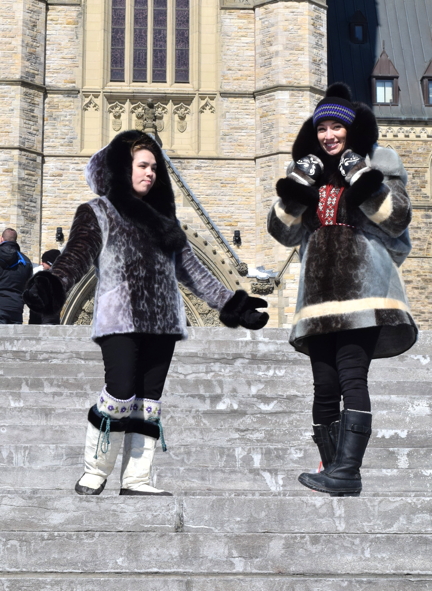Pride trumps fear for Inuit at sealing event on Parliament Hill
OTTAWA — Nanuk Kulu never had the courage to wear seal skin in the South.
Kulu, who prefers we use “they” instead of he or she, was always fearful of what might happen if they did. And for good reason. Kulu has seen activists in Ottawa singling out strangers wearing fur and slapping neon stickers on them that read “I’m an asshole I wear fur,” the latest from anti-fur activists PETA, People for the Ethical Treatment of Animals.
Kulu, isn’t the only person who’s reluctant to wear seal skin on southern city streets.
But they and other Nunavut Sivuniksavut students in Ottawa put aside their fears March 17, donned sealskin clothing and proudly gathered in Ottawa for a pro-sealing rally on Parliament Hill.

The rally was a way for NS students to counteract anti-sealing protests that often take place in the city. But it was also an opportunity for Kulu and others like them to feel pride in their heritage without fear of harassment or bullying.
Having just finished a two-week unit on the sealing industry, the youth demonstrated their newfound knowledge to a few dozen spectators, which appeared evenly split between Inuk and non-Inuk, on the staircase in front of Parliament’s centre block.
The afternoon event was topped off with a seal skin fashion show where NS students had fun showing off their sealskin coats of various shapes, colours and designs.
Jamie Takkiruq was the event’s emcee, entertaining the crowd with jokes, often blending history with humour.
“Inuit have relied on sealing for thousands of years,” Takkiruq said, opening the show in narration. “The hunters go out on the land in search for food. They travelled by dog sled to provide for their family.”
He introduced a throat song to show the crowd the “huffing and puffing” of a dog team in the age-old game.
“The hunter stands beside a seal hole, waiting,” Takkiruq said, as other NS students acted out the dramatization.
“He is still. He places a feather upon the water within the hole, to keep watch of the movement. It’s minus 50 degrees Celsius. Finally, a seal is caught! The hunter gives the seal one last drink of water to help its spirit move on to the after life.”
The students performed songs and dances related to seals, hunting and water, and entertained the crowd in between the hunting dramatization and the fashion show. The sealskin coats they wore were on loan from the Government of Nunavut’s environment department.
“Harvested by hunters, crafted by skilled seamstresses, the tradition continues to be an important part of our lives,” Takkiruq said.
Paige Runolfson of Ottawa, who stopped to watch the pro-sealing rally, believes the controversy around seal hunting is hurtful. It’s like their cows, Runolfson said.
“We don’t think twice about going into McDonald’s to get a burger but those people have to think twice about, you know, killing a seal so they can eat,” Runolfson said.
“People always tell people how to be and how to act and it’s like, no, that’s their heritage, it is their way of life. It’s like taking your cow away and saying no more McDonalds, no more A&W’s, no more all these places.”
As for Kulu and their colleagues, they hope the harassment stops and with it the fear Inuit have of showing off their culture in public and for supporting the sea hunt.
Kulu believes anti-fur protestors fail to understand that “fighting the traditional and sustainable seal hunt is in itself fighting for colonialism.”
“They believe that their anti-fur social movements are more important than indigenous cultural survival,” Kulu says. “They believe that Inuit need to give up this part of their culture and turn their backs to the time honoured tradition and history of their ancestors.”
“Whether they know it or not, they are asking that Inuit abandon who they are as a people and conform to the western idealisms that are once again being forced upon them. And that itself is a force of colonial violence.”